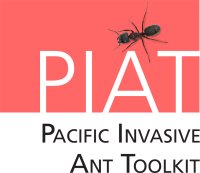Similar groove-headed ant
|
lives on ground |
day active |
|
Scientific name: Tetramorium simillimum Size: 2-2.7 mm Colour: yellowish to reddish pale brown General description: this small ant is pale in colour Habitat and nesting: the similar groove-headed ant is typically a ground dwelling species in open disturbed areas, around buildings and along the edges of forest tracks and roads. In its native range the ant may also make its nests in crevices of trees and in rotting wood. However, this nesting behaviour has not been reported in its invaded range. Rate of spread: unknown. Distribution: see our invasive ant distributions page for the worldwide distribution of the similar groove-headed ant. Reproduction: no information found. For detailed descriptions and identification of the simiar groove-headed ant: PIAkey: Tetramorium simillimum (see diagnostic characters tab) |
Close-up of a similar groove-headed ant worker (© Eli Sarnat, Creative Commons Attribution, Share Alike CC BY-SA License) |
Social, agricultural and environmental impacts of the similar-groove headed ant
Impacts of the similar groove-headed ant have not been well studied. As they can reach high densities in disturbed areas, they likely negatively affect native biodiversity.

Similar groove-headed ants foraging on peanut butter (© Eli Sarnat, Creative Commons Attribution, Share Alike CC BY-SA License) |
Video of similar groove-headed ants foraging on peanut butter in Fiji, Vimeo video (© Eli Sarnat, Creative Commons Attribution, Share Alike CC BY-SA License) |
Information sources
AntWiki, Similar groove-headed ant
Biosecurity New Zealand Invasive Ant Threat Information Sheet number 37, Similar groove-headed ant
Global Register of Introduced and Invasive Species (GRIIS)
PIAkey, Similar groove-headed ant
Content reviewed by Eli Sarnat, Antwork Consulting, LLC, June 2017

